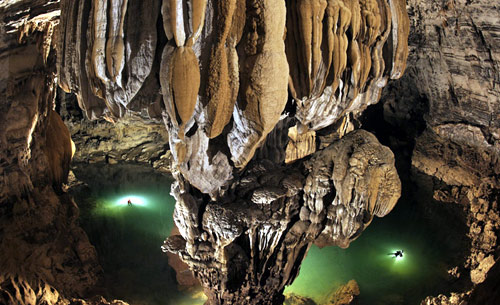
Son Doong in the central province of Quang Binh is well-known as the world's largest cave. Discovered in 2009, it is now one of the hottest spots in Vietnam and the nation's most expensive tours.
Son Doong in the central province of Quang Binh is well-known as the world’s largest cave. Discovered in 2009, it is now one of the hottest spots in Vietnam and the nation’s most expensive tours.
According to Axalis, the travel agency offering the Son Doong adventure their tours are fully booked until 2016. What is more, over a thousand international tourists who applied to take the tour were rejected due to a lack of fitness. The price of the tour is around US$3,000 per person.
Son Doong cave is a very special place and only 224 tourists are allowed to enter per year. The local authority also limits the number of tours to four per month.
 |
| The cave is selected as one of the most beautiful in the globe by the BBC (Photo:sondoongcave.org) |
It is hidden in Phong Nha-Ke Bang National Park in Bo Trach district, Quang Binh province, near the Laos-Vietnam border. The name Son Doong means ‘mountain river cave’. It was created 2-5 million years ago by river water eroding the limestone underneath the mountain.
It was found by a local man named Ho Khanh in 1991 and then discovered in 2009 by British cavers in an expedition led by Howard Limbert. During the first expedition, the team explored two and a half miles of the cave before a 200 foot wall of muddy calcite stopped them. They named it the Great Wall of Vietnam.
Limbert says the cave is five times larger than Phong Nha cave, which was previously considered the biggest cave in Vietnam. The biggest chamber of Son Doong is over 5km in length, 200m high and 150m wide.
Due to the adventurous nature of the tour British caving expert Limbert has set many strict criteria. The tour is for tourists in good health and with a high level of fitness as there is a lot of trekking involved each day.
A few years ago I was fortunate to visit this natural wonder. It took around two days of trekking and climbing in the tropical forest to reach the Son Doong. Though we were only allowed to go into a small part of the cave, it was really amazing for us to have this rare chance.
First we had to walk along soil paths zigzagging up and down through the thick primary jungle. Though it was the dry season, sudden jungle rains made us wet and cold while the path became muddy and slippery with lots of hungry green leeches. The path leads us to the Rao Thuong spring where water runs smoothly among big pebbles and rocks.
The route along the spring was easier to walk on. We then stopped at Ban Doong village where there are only 6-7 thatched houses of the Van Kieu ethnic group. The Van Kieu are very poor and have sparsely furnished houses.
Passing Dong village, we walked around 4km more through thick banana forests and brushwood to reach Hang En Cave with a spring running through it. We could not see anything inside the utterly dark cave. A creepy feeling came over us, but then suddenly hundreds of white butterflies flew out like we were in a fairy tale.
We set up camp and prepared food for dinner inside the giant cave. After a night of poor sleep due to the strange sound of wind and wild animals, we continued our trip to Son Doong via thick forests and springs, the path became harder to follow as the spring became deeper and faster-flowing. We were covered in mud and water from head to foot.
 |
|
Not all tourists are allowed to take an adventure tour of the cave (Photo:sondoongcave.org) |
Overcoming many canyons with sharp rock cliffs, we then faced the legendary Son Doong. The cave has an abrupt entrance so we had to drop down using robes. We only explored a small part of the cave due to lack of equipment, experience and fitness and a large abyss where we had to stop. We felt regret, but were still satisfied with what we had experienced. We had conquered Son Doong – the world’s biggest cave.
To preserve the pure and precious nature of the caves, local authorities have enacted many regulations. Everything is that is brought into Son Doong must be removed after every tour. On every tour, large double gas burners are used for the majority of cooking to save any wood being used. Only wood that has fallen outside the cave can be collected and brought to camp. No wood at all the jungles in the cave is used.
Rubbish bags are in position at the camps to help with rubbish collection. A single path is followed in the cave. No one is allowed from this path without permission from the guides. Nothing is allowed to be taken out of the cave or jungle and no one is allowed to touch any delicate formations.
Washing and bathing is only allowed in certain places where contamination can be limited. In Son Doong at least five new species have been identified in areas that are strictly controlled.
After leaving each camp the national Park Rangers do an inspection and sign off a document concerning the state of the camps.
It is in everybody’s interest to follow the rules and anyone found disregarding them will not be allowed to take part in the tour.
These rules will enable Son Doong to be kept in good condition for future generations so they can see this amazing natural wonder. It is up to all the people taking part in the tour to assist in the conservation of this new wonder of the world.
(Source:VOV)




